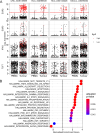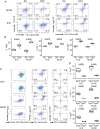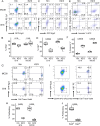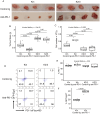Egr2 and 3 maintain anti-tumour responses of exhausted tumour infiltrating CD8 + T cells
- PMID: 36342511
- PMCID: PMC10110685
- DOI: 10.1007/s00262-022-03319-w
Egr2 and 3 maintain anti-tumour responses of exhausted tumour infiltrating CD8 + T cells
Abstract
Although T cells can develop into an exhausted state in the tumour microenvironment, tumour infiltrating T cells (TILs) are important to control tumour growth. By analysing single cell RNA-sequencing data from human tumours, we found that the transcription factors Early Growth Response 2 (EGR2) and 3 were highly induced in TILs, but not peripheral CD8 + T cells, in multiple patient cohorts. We found that deficiency of Egr2 and 3 in T cells resulted in enhanced tumour growth and fewer TILs in mouse models. Egr2 is highly expressed together with checkpoint molecules in a proportion of CD8 + TILs and Egr2high cells exhibit better survival and proliferation than Egr2-/-Egr3-/- and Egr2low TILs. Anti-PD-1 treatment increases Egr2 expression in CD8 + TILs and reduces tumour growth, while anti-PD-1 efficacy is abrogated in the absence of Egr2 and 3. Thus, Egr2 and 3 are important for maintaining anti-tumour responses of exhausted CD8 + TILs.
Keywords: Anti-PD-1; Egr2; Egr3; Tumour infiltrating lymphocytes.
© 2022. The Author(s).
Conflict of interest statement
The authors have no relevant financial or non-financial interests to disclose.
Figures







Similar articles
-
TOX-expressing terminally exhausted tumor-infiltrating CD8+ T cells are reinvigorated by co-blockade of PD-1 and TIGIT in bladder cancer.Cancer Lett. 2021 Feb 28;499:137-147. doi: 10.1016/j.canlet.2020.11.035. Epub 2020 Nov 27. Cancer Lett. 2021. PMID: 33249194
-
Prognostic impact of CD8-positive tumour-infiltrating lymphocytes and PD-L1 expression in salivary gland cancer.Oral Oncol. 2020 Dec;111:104931. doi: 10.1016/j.oraloncology.2020.104931. Epub 2020 Jul 28. Oral Oncol. 2020. PMID: 32736208
-
4-1BB Delineates Distinct Activation Status of Exhausted Tumor-Infiltrating CD8+ T Cells in Hepatocellular Carcinoma.Hepatology. 2020 Mar;71(3):955-971. doi: 10.1002/hep.30881. Epub 2019 Oct 18. Hepatology. 2020. PMID: 31353502 Free PMC article.
-
A Systematic Review of the Tumor-Infiltrating CD8+ T-Cells/PD-L1 Axis in High-Grade Glial Tumors: Toward Personalized Immuno-Oncology.Front Immunol. 2021 Sep 17;12:734956. doi: 10.3389/fimmu.2021.734956. eCollection 2021. Front Immunol. 2021. PMID: 34603316 Free PMC article.
-
Phenotypic and spatial heterogeneity of CD8+ tumour infiltrating lymphocytes.Mol Cancer. 2024 Sep 9;23(1):193. doi: 10.1186/s12943-024-02104-w. Mol Cancer. 2024. PMID: 39251981 Free PMC article. Review.
Cited by
-
Multifaceted regulatory mechanisms of the EGR family in tumours and prospects for therapeutic applications (Review).Int J Mol Med. 2025 Jul;56(1):113. doi: 10.3892/ijmm.2025.5554. Epub 2025 May 30. Int J Mol Med. 2025. PMID: 40444475 Free PMC article. Review.
-
C6 Ceramide Inhibits Canine Mammary Cancer Growth and Metastasis by Targeting EGR3 through JAK1/STAT3 Signaling.Animals (Basel). 2024 Jan 27;14(3):422. doi: 10.3390/ani14030422. Animals (Basel). 2024. PMID: 38338065 Free PMC article.
-
Spatial transcriptomics reveal high T cell and monocyte status as predictive and prognostic markers in pancreatic cancer.J Transl Med. 2025 May 23;23(1):576. doi: 10.1186/s12967-025-06599-9. J Transl Med. 2025. PMID: 40410886 Free PMC article.
References
MeSH terms
Substances
Grants and funding
LinkOut - more resources
Full Text Sources
Medical
Molecular Biology Databases
Research Materials

